Do you know hummingbirds love bright red, orange, and pink flowers? They prefer flowers shaped like tubes that have a lot of nectar. To pick plants they’ll visit, choose ones that are colorful, shaped like tubes, and bloom for a long time. This helps keep flowers blooming all year1.
A garden with different flowers that bloom at various times gives hummingbirds food all the time1. Whether you plant annuals like zinnias and petunias or perennials like salvia, making the right picks and taking care of your garden will make it a welcoming place for hummingbirds.
Key Takeaways:
- Hummingbirds are attracted to brightly colored, nectar-rich, tubular flowers1.
- Diverse planting with staggered bloom times ensures continuous nectar supply1.
- Annuals like zinnias and petunias are excellent for attracting hummingbirds2.
- Perennials like salvia provide long-term nectar sources1.
- Proper cultivation practices, such as ensuring appropriate sun and soil conditions, enhance the appeal of these plants to hummingbirds1.
Introduction to Hummingbird-Friendly Gardens
To make a garden that hummingbirds love, pick the right flowers. They like flowers that are shaped like tubes and very colorful. This helps them feed and stay healthy.
Why Hummingbirds Love Specific Flowers
Hummingbirds go for flowers with lots of nectar, especially native ones.3 These plants are top choices for feeding hummingbirds.3 They eat a lot of nectar daily, needing flowers that make plenty of it.4
The Importance of Bright Colors and Nectar
Hummingbirds are drawn to bright flowers, like red, orange, and pink ones.3 They see these colors well, which signals good nectar sources. This nectar is most of their food.5 So, gardeners often plant red and other bright flowers to invite these birds.
The Role of Tubular Flowers in Hummingbird Attraction
Tube-shaped flowers are great for hummingbirds because they fit their long bills. Flowers like crocosmia and fuchsias work well.3 They help hummingbirds eat easier and get more nectar. Also, hummingbirds like zinnias and salvia.3 These have tube shapes and bright colors.
Planting these types of flowers will make your garden beautiful and welcoming to hummingbirds. It gives them plenty of food and a nice place to live.
Best Annuals to Attract Hummingbirds
Getting hummingbirds to visit your garden is truly special. Choosing the right flowers is key. Annuals like zinnias, petunias, and calibrachoa attract them with bright colors and lots of nectar. Here are some top picks for your garden.
Zinnias
Zinnias come in bright colors and many sizes. They attract hummingbirds, butterflies, and birds with their nectar. They grow easily and bloom all season6. Put them in full sun and well-drained soil to see them thrive.
Petunias
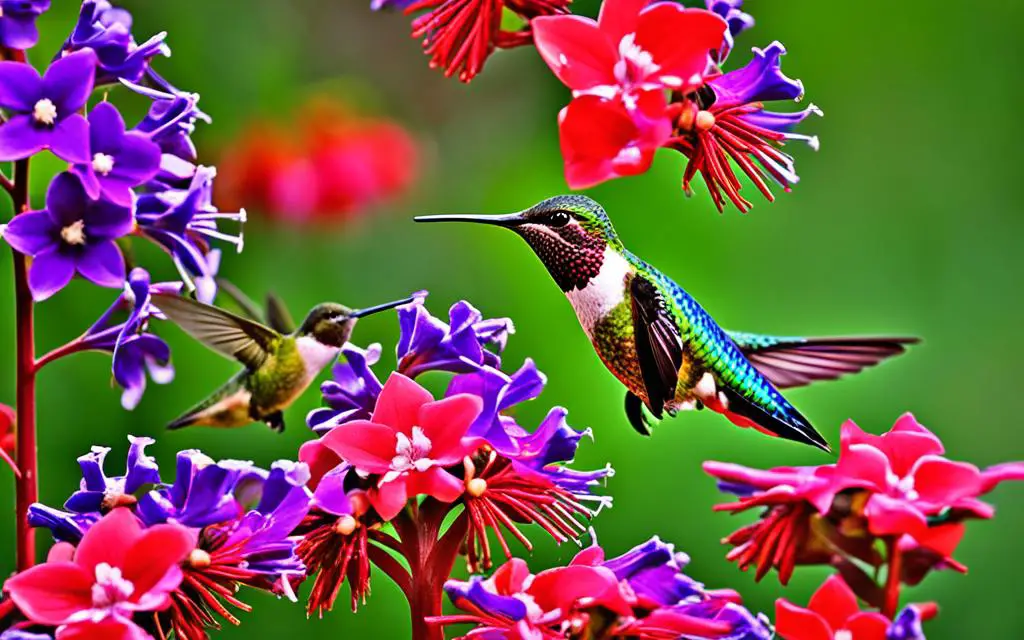
Petunias are loved for attracting hummingbirds. They bloom all summer, offering endless nectar. They’re easy to care for, needing only water and some deadheading. In full sun and good soil, petunias will feed hummingbirds all summer long7.
Calibrachoa
Calibrachoa looks like small petunias. They have bell-shaped blooms. These plants are perfect for pots and beds6. They need full sun and well-drained soil. With water and fertilizer, they’ll draw hummingbirds all season.
Adding these flowers to your garden will surely bring hummingbirds. You’ll enjoy a bright and active garden.
Perennial Favorites for Hummingbirds
Perennial flowers are great for hummingbirds. They need less care and cost less than yearly plants. They give hummingbirds nectar all season8. Here are some top perennial flowers that hummingbirds love:
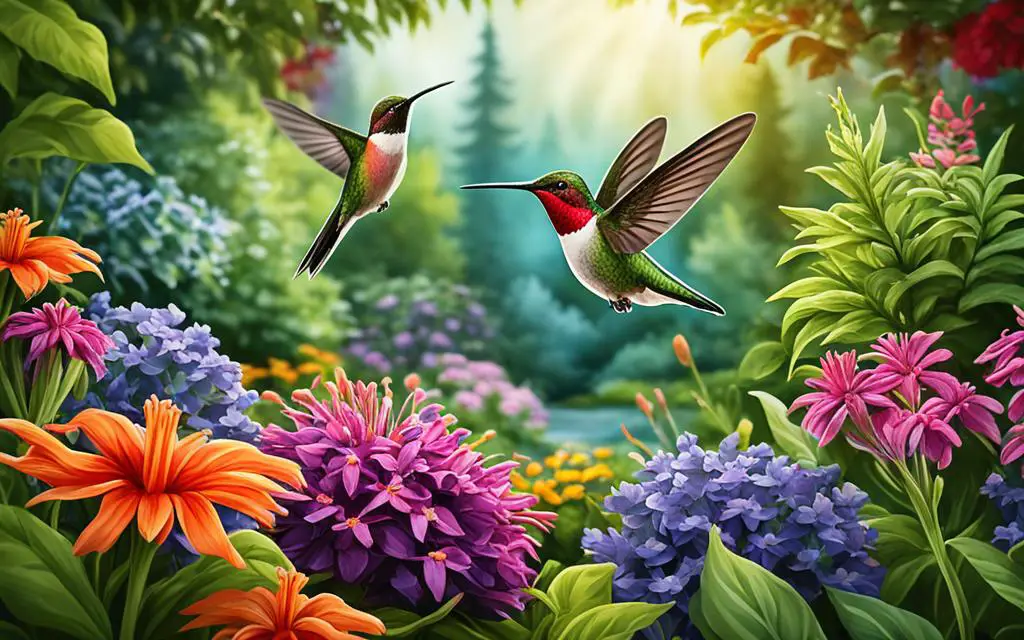
Bee Balm (Monarda didyma)
Bee balm has bright, tubular flowers that hummingbirds can’t resist. Its flower clusters are full of nectar. Bee balm likes sunny to partly shady spots and needs good soil. It also helps attract monarch butterflies.
Cardinal Flower (Lobelia cardinalis)
The cardinal flower has bold red blooms that hummingbirds love for their nectar. It likes moist soil and does well in sun or shade. It keeps giving nectar during its blooming time8.
Salvia (Salvia nemarosa, Salvia greggii)
Salvias are key in a hummingbird garden. They have flower spikes full of nectar. Salvias bloom often, keeping hummingbirds fed8. They grow well in sun or shade and in many soils.
Adding these perennials will make your garden look good and help feed hummingbirds.
Top Flowering Shrubs for Hummingbirds
Hummingbirds love flowering shrubs with bright blooms and lots of nectar. The butterfly bush and rose of sharon are great. They feed and shelter hummingbirds, making them key for any garden.
Butterfly Bush (Buddleia davidii)
The butterfly bush has long clusters of purple flowers. It blooms all season. This shrub needs little water and loves the sun.
It’s perfect for those who want to attract hummingbirds easily. The butterfly bush is important for hummingbirds and pollinators9. Its flowers keep hummingbirds coming back.
Rose of Sharon (Hibiscus syriacus)
The rose of sharon is great for attracting hummingbirds too. It has trumpet-shaped flowers and grows in many places. Its flowers offer lots of nectar for hummingbirds during bloom time.
It’s admired for its purple flowers and adaptability10. Plus, it gives birds a place to hide, which they love.
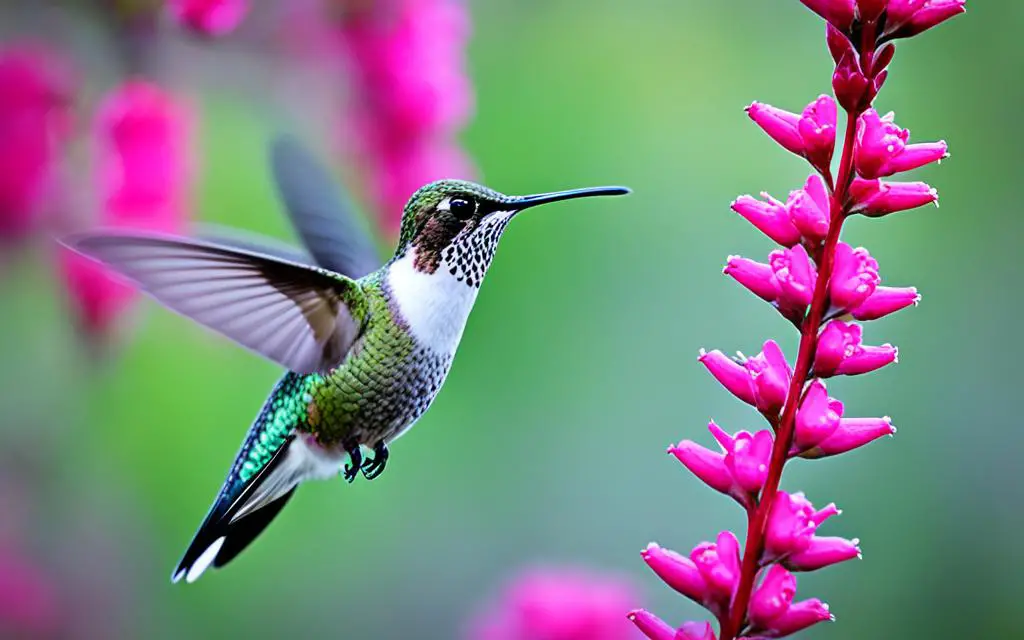
Add these shrubs to your garden to welcome hummingbirds. The butterfly bush and rose of sharon have beautiful flowers and nectar. They’re essential for creating a hummingbird-friendly garden.
Vines That Hummingbirds Love
Two vines stand out for attracting hummingbirds: the trumpet honeysuckle and trumpet creeper. Their tubular flowers and lots of nectar catch the birds’ eyes. They add beauty and feed hummingbirds by using up vertical space in your garden.
Trumpet Honeysuckle (Lonicera sempervirens)
Hummingbird fans love the trumpet honeysuckle. It has bright, tube-shaped flowers and can grow up to 12 feet high. It does well in zones 4 to 91112. Its red flowers not only look great but also have lots of nectar–perfect for hummingbirds. This vine likes sunny or partly shaded spots and soil that drains well.
Regular cuts help keep it under control and stop it from spreading too much.
Trumpet Creeper (Campsis radicans)
The trumpet vine can grow very tall, up to 40 feet, and also likes zones 4 to 9111312. It’s a top pick for hummingbirds because it offers much more nectar than most plants13. With its big, orange to red flowers, it’s very inviting to these birds.
In America, it grows wild but can get out of hand, so trim it often to keep it looking good13. Although deer don’t bother it, it might get powdery mildew or leaf spots13.
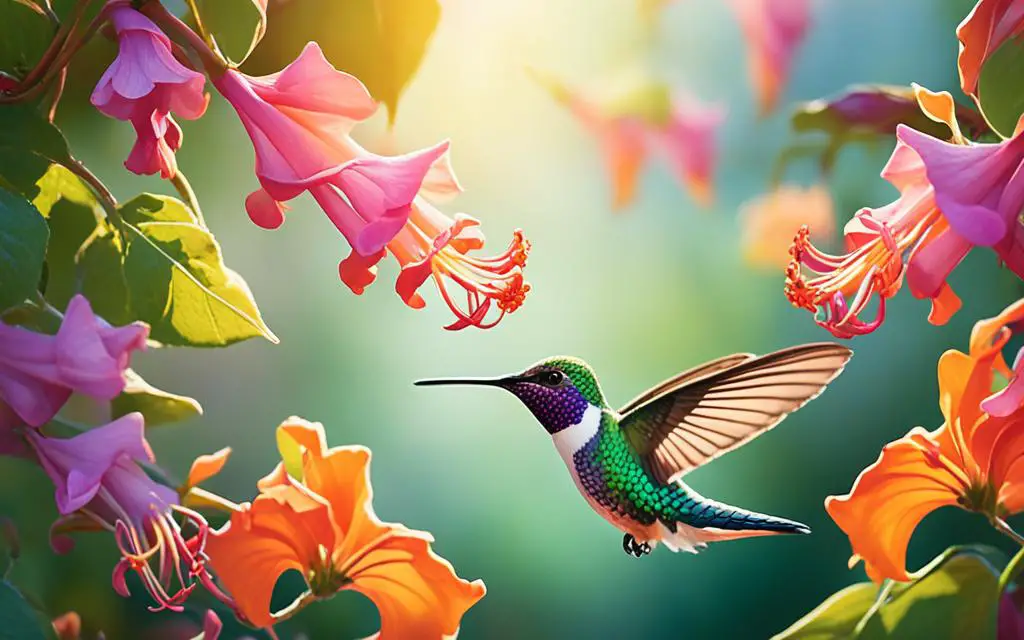
Less Common Hummingbird Attracting Flowers
Plan your garden with unique flowers like penstemon and columbine. These provide a special treat for you and the hummingbirds.
Penstemon (Penstemon spp.)
Penstemon, known as beardtongue, has bell-shaped blooms full of nectar. Hummingbirds love them. They grow well in full sun and are perfect for USDA zones 3 to 9. They can get 1 to 4 feet tall214. Penstemon plants are beautiful and easy to care for.
Columbine (Aquilegia canadensis)
Columbine flowers have unique spurred petals. They attract hummingbirds in late spring. These plants fit well in USDA zones 3 to 8 and grow 1 to 3 feet tall2. They come in reds and oranges, adding beauty to hummingbird gardens15. Their delicate look adds variety all bloom season.
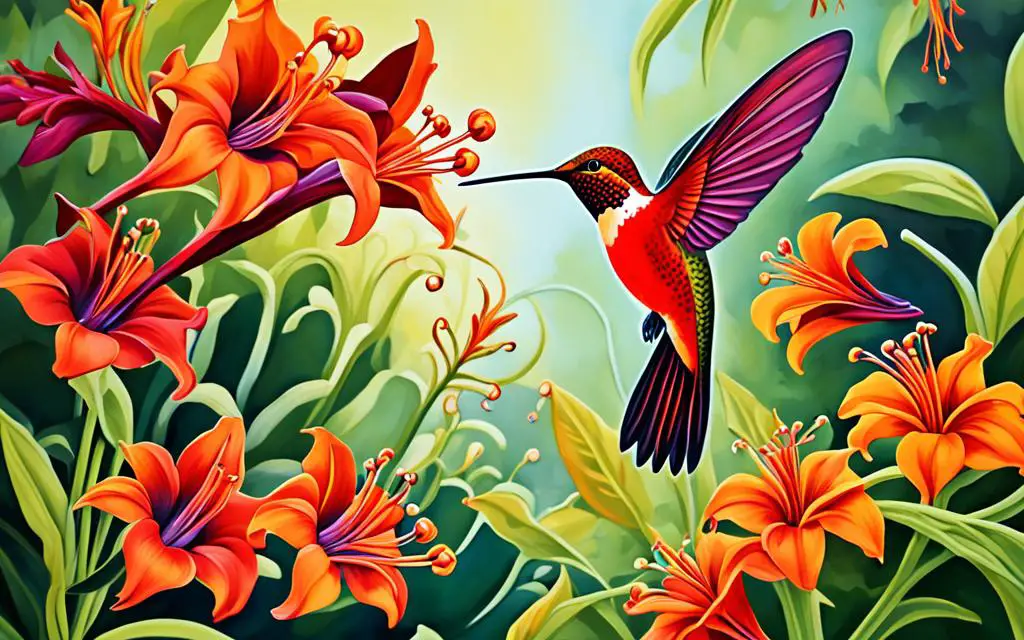
Add these special flowers to your garden. They invite hummingbirds and make your space stunning with their colors and shapes.
Planting Tips for a Hummingbird Garden
When creating a hummingbird garden, think about the sunlight, soil, and water. These things help you make a place where hummingbirds love to be. This way, you can enjoy their visits all year round.
Optimal Sun Exposure
Getting the sun right for hummingbird plants is key. Nectar-filled flowers that hummingbirds love do best in plenty of sun. Hummingbirds visit over 1,000 flowers daily for nectar3. Bee Balm and Cardinal Flower grow well in these conditions14.
Soil Needs and Fertilization
Good soil and food for the plants matter a lot. Since hummingbirds eat a lot of nectar, the plants need healthy soil. Adding stuff like compost helps plants avoid diseases. Plants like Agastache grow tall and strong in such soil14.
Watering Practices
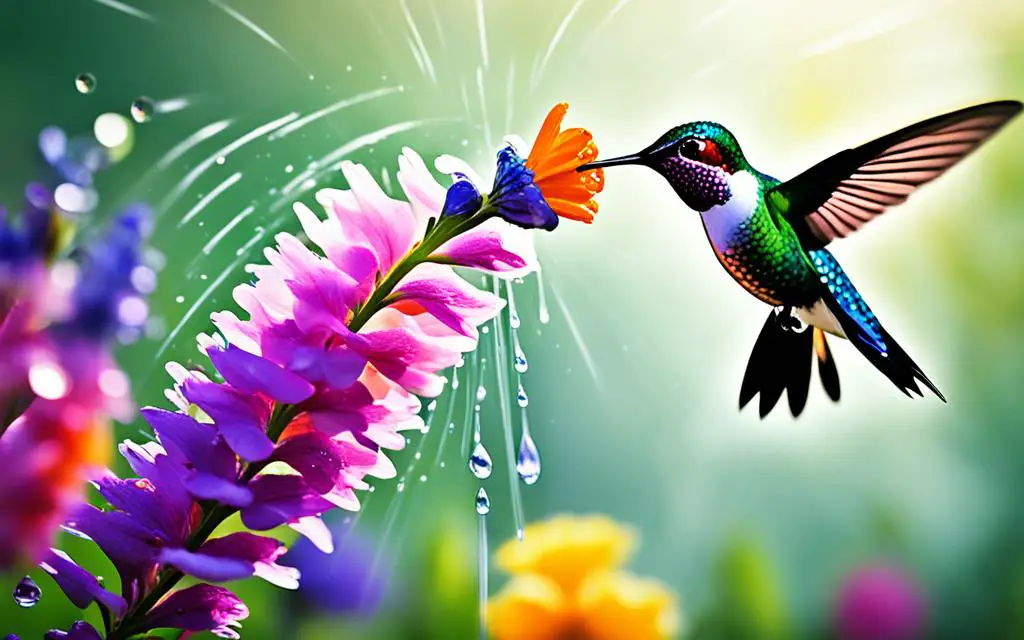
Flowers need the right amount of water to make nectar. But too much water can cause problems. Hummingbirds have fast heart rates and need constant nectar3. Water your garden well but don’t make it too wet. This keeps plants happy and healthy.
| Plant | Zones | Height | Sun Exposure | Soil Needs |
|---|---|---|---|---|
| Bee Balm (Monarda) | 4 to 9 | Up to 4 feet | Full Sun to Partial Shade | Fertile, Well-draining |
| Cardinal Flower (Lobelia cardinalis) | 2 to 9 | 3 to 4 feet | Full Sun to Partial Shade | Moist, Rich Soil |
| Agastache | 4 to 9 | 1 to 5 feet | Full Sun to Partial Shade | Fertile, Well-draining |
| Trumpet Honeysuckle (Lonicera sempervirens) | 4 to 10 | 10 to 20 feet (vine) | Full Sun to Partial Shade | Well-draining |
Creating a Continuous Bloom Cycle
To attract hummingbirds all season, plan your garden with care. Use a mix of flowers that bloom at different times. This way, hummingbirds always have nectar available.
Staggering Bloom Times
Hummingbirds need nectar all the time. Choose plants that bloom at different times. Start with early bloomers like columbine, add mid-season flowers like bee balm, and end with late bloomers like trumpet creeper. This will keep nectar flowing.
Adding flowers of different shapes attracts more pollinators2.
Using a Mix of Annuals, Perennials, and Shrubs
Mixing annuals, perennials, and shrubs makes a hummingbird haven. Combine quick-blooming annuals like zinnias with lasting perennials like salvia. Add in shrubs like rose of Sharon for variety. This mix gives hummingbirds reasons to keep coming back2.
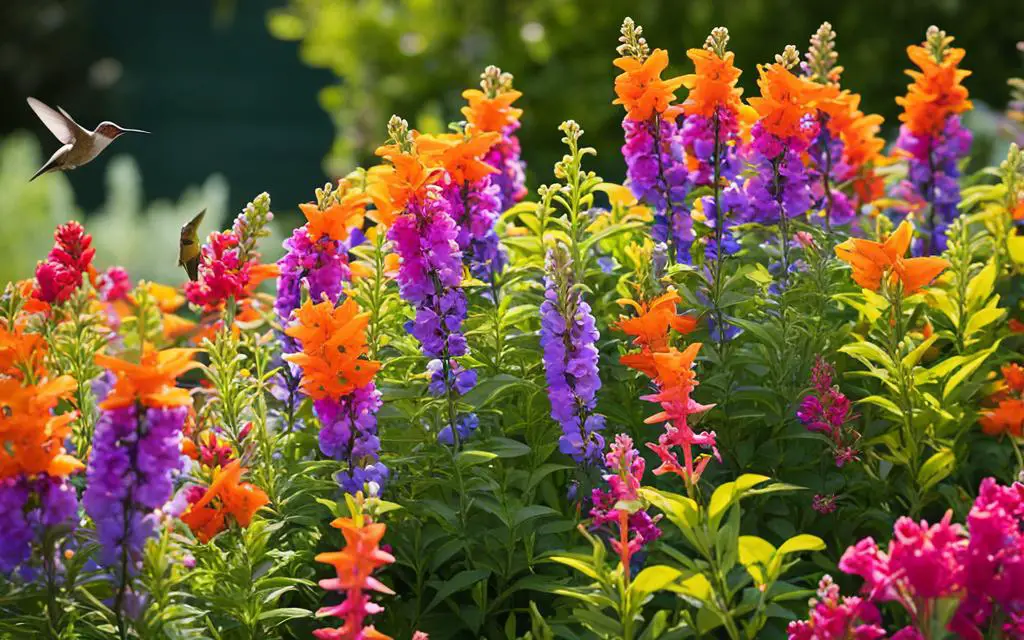
These plants fit in Zones 2 to 11, so many places can grow them. They come in many colors like red, purple, and blue2. Make sure they get the right sun and soil. This helps your garden and supports hummingbirds all year16.
Hummingbirds Favorite Flowers
Adding different flowers to your garden attracts hummingbirds all year. Various shapes, sizes, and colors give these birds the nectar they need. This makes any garden look more charming and lively.
Importance of Flower Variety
Including lots of flowers is key for a hummingbird garden. They love bright, tubular flowers for their vivid colors and rich nectar. This keeps the birds coming and makes your garden beautiful.
Examples of Flowers Hummingbirds Prefer
Hummingbirds like many flowers. Cardinal Flowers are tall and come in scarlet, white, and rose2. Bee Balm is another favorite, growing up to 4 feet tall, offering nectar all season14. Zinnia attracts both hummingbirds and other pollinators, coming in many colors except blue and brown2.
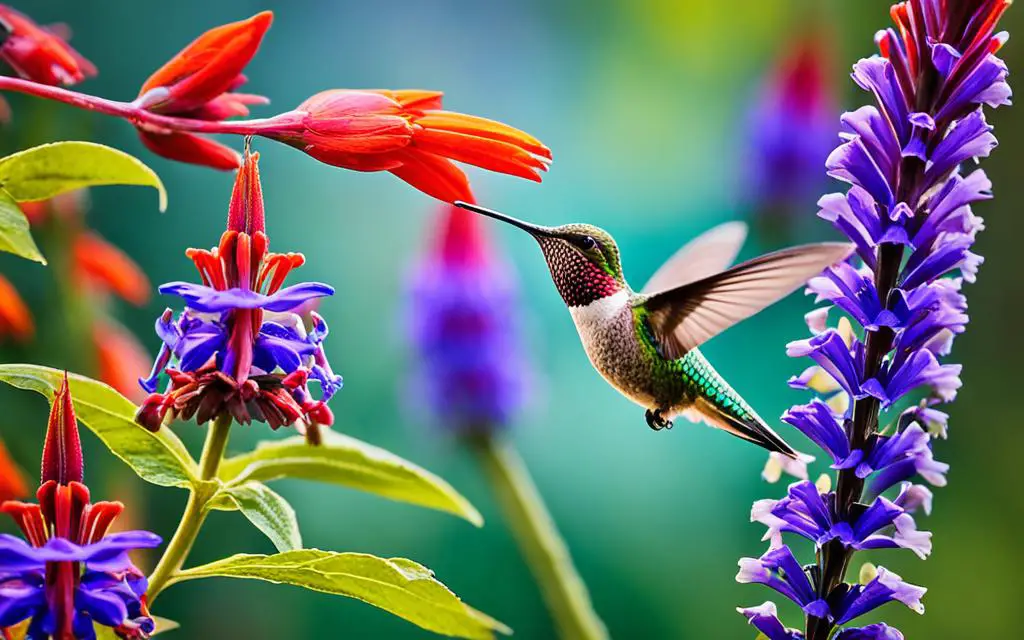
Salvia plants bloom in summer, perfect for hummingbirds2. Trumpet Honeysuckle has long vines and comes in many colors, offering early spring nectar14. Penstemon, or Beardtongue, has bell-shaped flowers full of nectar142.
Choosing these plants creates a colorful, welcoming space for hummingbirds. It brings them the food they need and makes your garden even prettier.
Conclusion
Making a hummingbird garden means more than just planting flowers. It’s about creating a garden that brings in pollinators and adds to biodiversity. Adding many nectar-filled plants, such as Salvias, is key. Salvias are a top choice for hummingbirds17. Add other flowers like bee balm, Columbine, and fuchsia too. They draw in hummingbirds with their nectar and shapes18. For a top-notch garden, get the right amount of sunlight, soil, and water. This lets plants grow well and bloom brightly18.
Having a mix of different flowers keeps hummingbirds coming back. They like groups of flowers more than single ones and love bright colors like red, pink, and orange18. Flowers with spots or stripes also attract these birds18. Adding such flowers makes your garden more interesting. It will not just bring in hummingbirds but make your outdoor space look better.
In the end, a good hummingbird garden is full of colors, smells, and shapes. It welcomes these lovely pollinators and helps your garden thrive. By planting a variety of their favorite plants, you make a place where hummingbirds can thrive. This adds beauty and life to your garden.
Source Links
- https://www.monrovia.com/be-inspired/best-plants-for-hummingbirds.html
- https://www.thespruce.com/top-hummingbird-flowers-386271
- https://savvygardening.com/hummingbird-flowers/
- https://www.herbco.com/s-2962-hummingbird-gardens-herbs-and-flowers-for-hummingbirds.aspx
- https://www.audubon.org/community-science/hummingbirds/how-create-hummingbird-friendly-yard
- https://www.birdsandblooms.com/birding/attracting-hummingbirds/annual-flowers-that-attract-hummingbirds/
- https://fairviewgardencenter.com/blog/attracting-hummingbirds-with-annual-flowers/
- https://www.birdsandblooms.com/gardening/plants-and-flowers-to-attract-hummingbirds/best-perennials-hummingbirds/
- https://sugarcreekgardens.com/product-category/hummingbird-attracting-plants/
- https://www.birdsandblooms.com/gardening/top-10-lists-for-gardeners/hummingbird-bushes/
- https://www.bhg.com/vines-for-hummingbirds-7560321
- https://www.birdsandblooms.com/gardening/top10-vines-hummingbirds/
- https://www.birdsandblooms.com/gardening/plants-and-flowers-to-attract-hummingbirds/trumpet-vine/
- https://www.birdsandblooms.com/birding/attracting-hummingbirds/top-10-colorful-flowers-hummingbirds-love/
- https://www.almanac.com/plants-attract-hummingbirds
- https://dnr.illinois.gov/education/plantlists/plantlisthummingbird.html
- https://www.rutgersrugby.com/what-is-the-number-one-flower-that-attracts-hummingbirds/
- https://www.floraqueen.com/blog/what-flowers-do-hummingbirds-like

My name is Shane Warren, the author behind Your Bird Buddy – your ultimate guide to the wonderful world of birds! Unleash your inner avian explorer as we delve into a vibrant library of knowledge dedicated to all things feathered. From learning about diverse bird species from across the globe to understanding their captivating habitats and behaviors, I’m here to fuel your passion for these magnificent creatures. Not only that, but I also provide valuable insights on being a responsible and informed pet bird owner. Join our vibrant community and let’s celebrate the feathered wonders of the world together – one chirp at a time. And be sure to join our Your Bird Buddy Community over on Facebook!

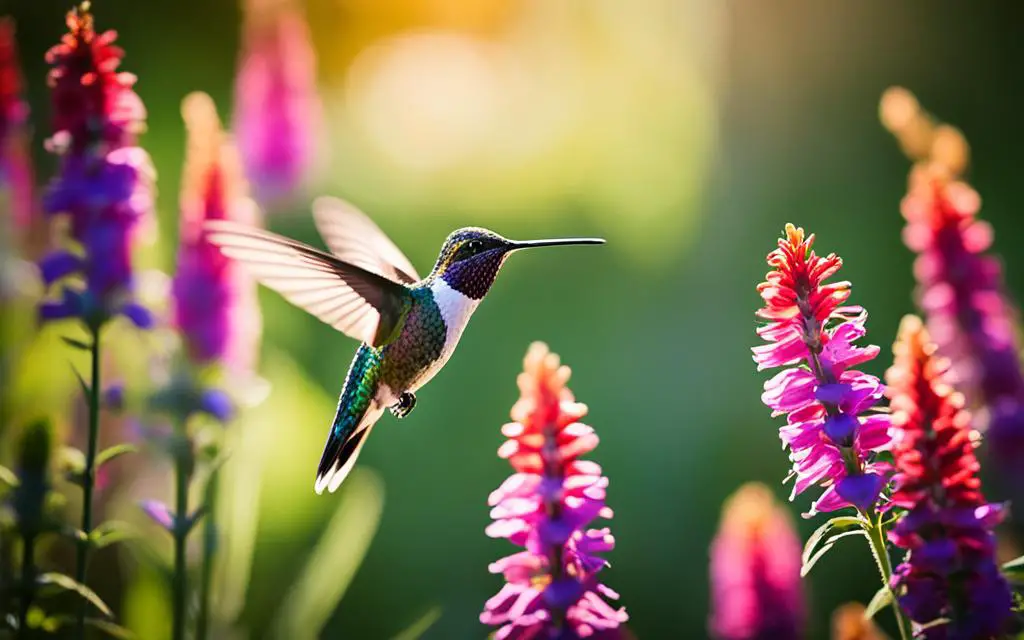
Comments are closed